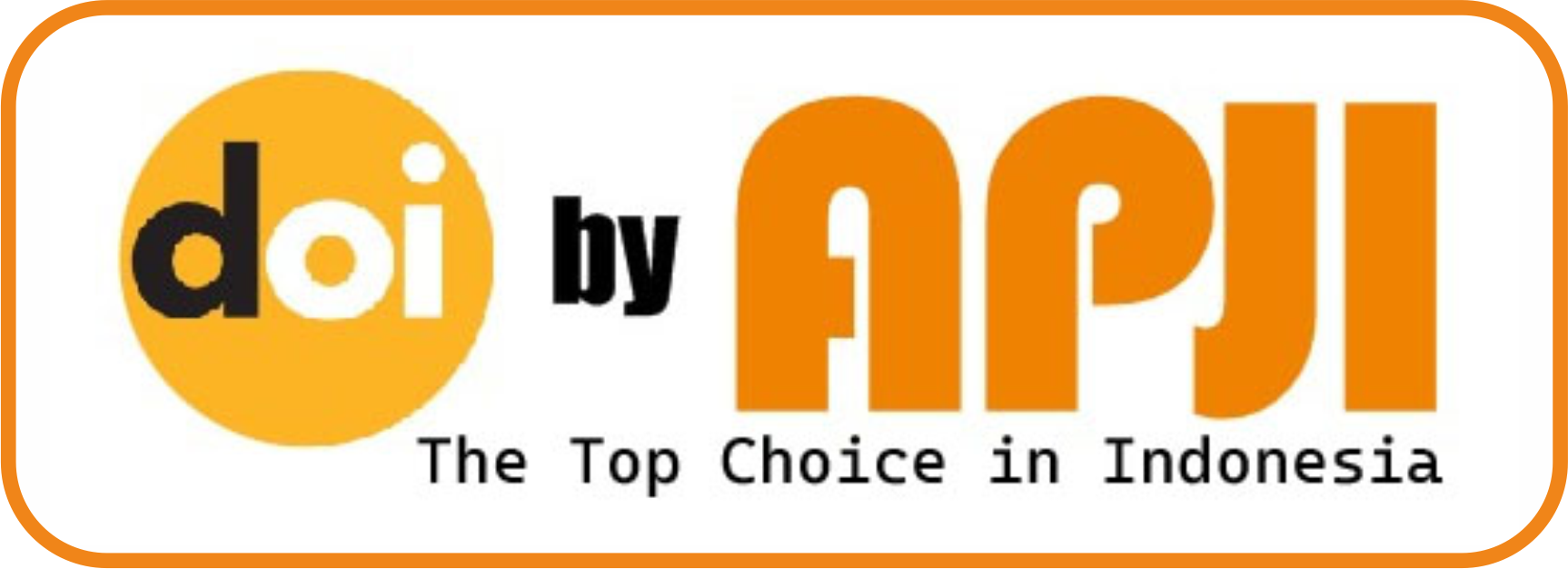Pengaruh Green Product Innovation Dan Green Process Innovation Terhadap Green Competitive Advantage (Studi Pada PT. Samcro Hyosung Adilestari)
DOI:
https://doi.org/10.55606/jupsim.v2i3.2029Kata Kunci:
Environmental Pollution, Green Competitive Advantage, Green Process Innovation, Green Product Innovation, IndustryAbstrak
Industry is a major problem in environmental pollution that has affected the earth for decades. Inorganic waste such as hazardous waste and toxic materials contribute to environmental pollution. Indonesia produces 60 million tons of hazardous and toxic waste in 2021. This study aims to determine the effect of Green Product Innovation and Green Process Innovation on Green Competitive Advantage at PT Samcro Hyosung Adilestari. The method used in this study uses a quantitative associative approach with a total sample of 78 respondents. The instrument used is a questionnaire. Validity and reliability tests are part of testing the quality of the instrument in this study. Data were analyzed by descriptive and correlation analysis and multiple linear regression analysis was used to test the hypothesis. The results of the study indicate that there is an effect of Green Product Innovation on Green Competitive Advantage and Green Process Innovation has no effect on Green Competitive Advantage..
Referensi
Albort-Morant, G., Leal-Millán, A., & Cepeda-Carrión, G. (2016). The antecedents of green innovation performance: A model of learning and capabilities. Journal of Business Research, 69(11), 4912–4917. https://doi.org/10.1016/j.jbusres.2016.04.052
Bocken, N. M. P., Farracho, M., Bosworth, R., & Kemp, R. (2014). The front-end of eco-innovation for eco-innovative small and medium sized companies. Journal of Engineering and Technology Management - JET-M, 31(1), 43–57. https://doi.org/10.1016/j.jengtecman.2013.10.004
Bowen, F., Cousins, P., Lamming, R.., & Farukt, A. (2009). The Role of Supply Management Capabilities in Green Supply. Production and Operations Management. 10. 174 - 189. https://doi.org/10.1111/j.1937-5956.2001.tb00077.x
Bigliardi, B., & Alvaro Ivo, D. (2009). An empirical investigation of innovation determinants in food machinery enterprises. European Journal of Innovation Management, 12 (2), 223–242. https://doi.org/10.1108/14601060910953988
Chang, C. H. (2011). The Influence of Corporate Environmental Ethics on Competitive Advantage: The Mediation Role of Green Innovation. Journal of Business Ethics, 104(3), 361–370. https://doi.org/10.1007/s10551-011-0914-x
Chen, Y. S., & Chang, C. H. (2013). The Determinants of Green Product Development Performance: Green Dynamic Capabilities, Green Transformational Leadership, and Green Creativity. Journal of Business Ethics, 116(1), 107–119. https://doi.org/10.1007/s10551-012-1452-x
Chen, Y. S., Lai, S. B., & Wen, C. T. (2006). The influence of green innovation performance on corporate advantage in Taiwan. Journal of Business Ethics, 67(4), 331–339. https://doi.org/10.1007/s10551-006-9025-5
Chiou, T. Y., Chan, H. K., Lettice, F., & Chung, S. H. (2011). The influence of greening the suppliers and green innovation on environmental performance and competitive advantage in Taiwan. Transportation Research Part E: Logistics and Transportation Review, 47(6), 822–836. https://doi.org/10.1016/j.tre.2011.05.016
Databoks.katadata.co.id. 9 Februari 2022. Indonesia Hasilkan 60 Juta Ton Limbah B3 pada 2021. Diakses pada 4 Januari 2023, dari https://databoks.katadata.co.id/datapublish/2022/02/09/indonesia-hasilkan-60-juta-ton-limbah-b3-pada-2021
Efendi, S., Dkk. (2019). Manajemen Operasional. Jakarta : LPS- UNAS
Ghozali I. (2009). Aplikasi Analisis Multivariate dengan Program SPSS. Penerbit: Universitas Dipenogoro. Semarang.
Ghozali, Imam. (2013). Aplikasi Analisis Multivariate dengan Program IBM SPSS 21 Update PLS Regresi. Semarang: Badan Penerbit Universitas Diponegoro
Ghozali, I. (2016). Aplikasi Analisis Multivariete Dengan Program IBM SPSS.Semarang: Badan Penerbit Universitas Diponegoro.
Hansmann, K. W., & Claudia, K. (2001). Environmental management policies. J. Sarkis (Ed.), Green manufacturing and operations: From design to delivery and back, 192–204. Sheffield, UK: Greenleaf Publishing.
Heizer, J dan Barry, R. (2009). Manajemen Operasi Buku 1 (Edisi 9). Jakarta: Salemba Empat.
Jebarus, Felix (2001). Supply Chain Management, Usahawan no :02 Th XXX Februari.
Kam‐Sing Wong, S. (2012). The influence of green product competitiveness on the success of green product innovation: Empirical evidence from the Chinese electrical and electronics industry, European Journal of Innovation Management, 15(4), 468-490. https://doi.org/10.1108/14601061211272385
Kivimaa, P., & Kautto, P. (2010). Making or breaking environmental innovation? Technological change and innovation markets in the pulp and paper industry. Management Research Review, 33(4), 289–305. https://doi.org/10.1108/01409171011030426
Krisnandi H., Efendi S., Sugiono E. (2019). Pengantar manajemen. Jakarta: LPU-UNAS.
Li, D., Zheng, M., Cao, C., Chen, X., Ren, S., & Huang, M. (2017). The impact of legitimacy pressure and corporate profitability on green innovation: Evidence from China top 100. Journal of Cleaner Production, 141, 41–49. https://doi.org/10.1016/j.jclepro.2016.08.123
Linton, J., Klassen, R., & Jayaraman, V. (2007). Sustainable Supply Chains: An Introduction. Journal of Operations Management. 25. https://doi.org/10.1016/j.jom.2007.01.012
Priyatno, Duwi. (2012). Cara Kilat Belajar Analisis Data dengan SPSS 20. Yogyakarta: Andi Offset.
Purba Rao, D. H. (2005). Do green supply chains lead to competitiveness and economic performance? International Journal of Operations & Production Management, 25(9), 898–916.
Qiu, L., Jie, X., Wang, Y., & Zhao, M. (2019). Green product innovation, green dynamic capability, and competitive advantage: Evidence from Chinese manufacturing enterprises. Corporate Social Responsibility and Environmental Management, 27(1), 146–165. https://doi.org/10.1002/csr.1780
Rao, P. (2002). Greening the supply chain: A new initiative in South East Asia. International Journal of Operations and Production Management, 21(6), 632–655. https://doi.org/10.1108/01443570210427668
Rao, P and Holt, D (2005) Do green supply chains lead to competitiveness and economic performance?, International Journal of Operation & Production Management, 25(9), 898-916. https://doi.org/10.1108/01443570510613956
Rusiadi, et al. (2016). Metode Penelitian Manajemen, Akuntansi dan Ekonomi Pembangunan, Konsep, Kasus dan Aplikasi SPSS, Eviews, Amos dan Lisrel (Cetakan Pertama). Medan : USU Press
Sekaran, Uma (1992). Research Methods for Business (3th Edition). Southern Illionis University
Simchi-Levi, D., Kaminsky, P., & Simchi-Levi, E. (2000) Designing and managing the supply chain: Concepts, strategies and case studies. New York: Irwin McGraw-Hill
Stoner, J. A. F., Freeman, R. E., dan Gilbert Jr, D. R. (1996). Manajemen. Jilid 1. Alih Bahasa: Drs. Alexander Sindoro. Jakarta: PT Prenhallindo.
Sugiyono. (2009). Metode Penelitian Kuantitatif, Kualitatif dan R&D. Bandung: Alfabeta.
Sugiyono. (2014). Metode Penelitian Pendidikan Pendekatan Kuantitatif, Kualitatif, dan R&D. Bandung: Alfabeta
Sugiyono. (2017). Metode Penelitian Kuantitatif, Kualitatif, dan R&D. Bandung: Alfabeta.
Sugiyono. (2019). Metode penelitian dan pengembangan (research and development/R&D). Bandung : Alfabeta
Sugiyono. (2021). Metode Penelitian Komunikasi (Kuantitatif, Kualitatif, dan Cara Mudah Menulis Artikel pada Jurnal Internasional). Bandung: Alfabeta
Sukardi. (2012). Metodologi Penelitian Pendidikan: Kompetensi dan Praktiknya. Jakarta: Bumi Aksara.
Sundarakani, B., De Souza, R., Goh, M., Wagner, S.M., Manikandan, S. (2010). Modeling carbon footprints across the supply chain. International Journal of Production Economics, 128 (1), 43–50. https://doi.org/10.1016/j.ijpe.2010.01.018
Suryati, S., & Murwaningsari, E. (2022). Pengaruh green competitive advantage dan pelaporan terintegrasi terhadap nilai perusahaan. Akurasi : Jurnal Studi Akuntansi Dan Keuangan, 5(2), 193–208. https://doi.org/10.29303/akurasi.v5i2.237
Susilo Y. E B. (2003). Menuju Keselarasan Lingkungan Memahami Sikap Teologis Manusia Terhadap Pencemaran Lingkungan. Surabaya: Averroes Press.
Terry, George R. (1953). Principles of Management. Homewood, Illinois: Richard D. Irwin.
Wijayanto, A., Suhadak, Dzulkirom, M., & Nuzula, N. F. (2019). The effect of competitive advantage on financial performance and firm value: Evidence from Indonesian manufacturing companies. Russian Journal of Agricultural and Socio-Economic Sciences, 85(1), 35–44. https://doi.org/10.18551/rjoas.2019-01.04
Wouters, M., Anderson, J.C., Narus, J.A., & Wynstra, F. (2009) Improving sourcing decisions in NPD projects: Monetary quantification of points of difference, Journal of Operations Management, 27 (1), 64-77.
Xie, X., Huo, J. & Zou, H. (2019). Green process innovation, green product innovation, and corporate financial performance: A content analysis method. Journal of business research, 101, 697-706. https://doi.org/10.1016/j.jbusres.2019.01.010
Zameer, H., Wang, Y., Yasmeen, H., & Mubarak, S. (2020). Green innovation as a mediator in the impact of business analytics and environmental orientation on green competitive advantage. Management Decision, 60(2), 488–507. https://doi.org/10.1108/MD-01-2020-0065
Zhu, Q., & Sarkis, J. (2004). Relationships Between Operational Practices and Performance Among Early Adopters of Green Supply Chain Management Practices in Chinese Manufacturing Enterprises. Journal of Operations Management. 22. 265-289. 10.1016/j.jom.2004.01.005.
Zhu, Q., Sarkis, J., & Lai, K. H. (2012). Green supply chain management innovation diffusion and its relationship to organizational improvement: An ecological modernization perspective. Journal of Engineering and Technology Management - JET-M, 29(1), 168–185. https://doi.org/10.1016/j.jengtecman.2011.09.012




















